Nacyjanalny Futbolny Stadion
| Capacity | 33 145 |
|---|---|
| Country | Belarus |
| City | Minsk |
| Clubs | - |
| Inauguration | 07/06/2025 |
| Construction | 2020–2025 |
| Design | IPPR International Engineering Corporation |
| Contractor | Beijing Urban Construction Group |
Advertisement
Nacyjanalny Futbolny Stadion – stadium description
What is the Nacyjanalny Futbolny Stadion like in a nutshell?
A modern national stadium in Minsk had been planned since 2010, but subsequent attempts ended in failure. Finally, help came from China, which decided to build a new arena as a gift to the Belarusian people and a symbol of friendship between the two countries.
For years, China has engaged in so-called “stadium diplomacy”, funding new stadiums around the world in exchange for increased trade cooperation, while also seeking to improve its international image.
Until now, the Chinese have mainly built new stadiums in Africa – the new stadium in Minsk was the first investment of this kind in Europe and was treated as a very prestigious project. In addition to the stadium, the Chinese also promised to build an Olympic swimming pool, which was constructed in another part of the city.
Chinese leader Xi Jinping was personally involved in the project, and the stadium itself was designed to very high standards, with great attention to detail and local context – it features clear references to the national flag and colors.
Construction began in the summer of 2020, in the midst of the COVID-19 pandemic, and it took another five years for the stadium to open. The inauguration was addressed by none other than President Alexander Lukashenko, who also announced that a monument to Xi Jinping would be erected next to the facility.
The Nacyjanalny Futbolny Stadion (National Football Stadium) can seat over 33,000 spectators and is the largest and most modern stadium in Belarus. A museum of Belarusian football was also built adjacent to the stadium.
The hallmark of the facility is its unique facade, composed of 472 vertical steel slats – each segment has a curve in the middle, which, when combined together, creates an interesting visual effect in the form of a gentle sine wave running along the facade.
Directly behind the steel slats, a translucent material has been placed, giving the building a distinctive red color. The facility is crowned with a contrasting, light-colored roof, around the perimeter of which runs a wide strip decorated with a traditional ornament known from the Belarusian flag.
Although the stadium has already been opened, Belarusians cannot fully use it: due to the Russian invasion of Ukraine, which is also being conducted from Belarusian territory, UEFA has ordered Belarusian clubs and the national team to play their home matches on neutral ground. So, as long as the war continues, the modern national stadium can only host friendly matches...
How was the Nacyjanalny Futbolny Stadion created?
What were the initial plans for the new football stadium in Minsk?
The first plans to build a modern football stadium in Minsk appeared in 2010. The facility was to accommodate 30,000 spectators, and a whole business complex was planned alongside it, with skyscrapers and a National Exhibition Center.
The facilities were to be built in Shchomyslitsa, in the distant southwestern suburbs of Minsk, where there were also plans to extend the metro line. The project was to cost half a billion dollars, and the additional business functions were to attract foreign investors.
Could the Dynama Stadium have become a football-specific venue?
In the end, nothing came of the investment in Shchomyslitsa, and instead work began on the reconstruction of the Dynama Stadium, which was planned to be transformed into a football-specific venue. In the summer of 2011, the city announced a tender for the reconstruction of the stadium, which was won by the Hungarian company Graboplan, but subsequent disagreements led to the failure of the project.
As part of another attempt, at the turn of 2012 and 2013, a competition was held for the architectural concept of the reconstruction of the Dynama Stadium, which was won by the German studio GMP Architekten.
Demolition of parts of the old stadium began in early 2013, but during the process it was decided to change the design – it was agreed that the facility should retain its athletics track, and a new concept was developed at the end of 2013 by the local firm UP Minskproekt.
The reconstruction of the Dynama Stadium was completed in 2018, and in June 2019, the modernized facility was the main venue for the 2nd edition of the European Games.
When were the plans to build a new facility next to the Traktor Stadium made?
However, the idea of building a football-specific stadium was not abandoned – in fact, in 2013, it was decided to go ahead with two stadium investments, because in addition to the reconstruction of the Dynama Stadium, the construction of a second, completely new facility was also planned, and the area right next to the Traktor Stadium was chosen as the location.
In this way, Minsk was to gain two modern stadiums: one with an athletics track (the modernized Dynama Stadium) and the other – a completely new, football-specific venue.
As a result, a new football stadium design was created – once again by GMP Architekten. In order to implement the project, the Dinamo Arena company was established, jointly created by the city authorities, the Belarusian Football Federation, and Triple, a company owned by Yury Chyzh, the owner of Dinamo Minsk.
The construction was to be completed within a budget of €100 million. The facility was to serve the national team as well as the club Dynamo Minsk. Additionally, it was submitted as part of Minsk's bid to host Euro 2020 matches. On July 18, 2014, Belarusian President Alexander Lukashenko signed a decree on the construction of the stadium.
What was the progress of the project to build a new facility next to the Traktor Stadium?
The selection of venues for Euro 2020, which was to be held across the continent, was made in September 2014, but Minsk's bid was not approved by UEFA officials and was rejected.
The failure to host Euro 2020 matches did not stop the investment. In March 2015, a tender was announced for the design and construction of the stadium as part of a public-private partnership. A whole commercial complex was to be built alongside the stadium. In November 2015, it was announced that an unspecified Chinese company had won the tender.
However, the contract was not signed immediately – further negotiations were held with the Chinese. In 2016, Triple withdrew from the project, and cooperation with the Chinese company was later terminated as well. However, the authorities remained determined to carry out the investment.
When did the Chinese decide to give the Belarusians a national stadium?
The breakthrough came in 2017. After Lukashenko's visit to China in May, it was announced that the Chinese authorities would provide assistance in the construction of the stadium. At a meeting with Chinese leader Xi Jinping, Lukashenko personally requested such support. The Chinese agreed to the proposal, deciding to build a new stadium in Minsk as a gift to the Belarusians.
The donation of the stadium was part of China's long-standing policy, known as “stadium diplomacy”, under which many stadium investments have already been made around the world (especially in African countries).
Along with the stadium, the Chinese were also to finance the construction of a high-class Olympic swimming pool (planned in another part of the city), with the value of both investments initially estimated at $180 million.
When was the design of the Nacyjanalny Futbolny Stadion presented?
On April 25, 2019, during Lukashenko's next visit to China, Xi Jinping presented the Belarusian leader with a model of the new stadium, designed by Chinese architects, at the Great Hall of the People. Shortly after this visit, photos of the model appeared in the media. Renderiogs of the facility were made public in the first half of 2020.
The design of the new stadium was developed by IPPR International Engineering Corporation.
The design of the Nacyjanalny Futbolny Stadion can be viewed on a separate subpage
When were the preparatory works for the construction of the Nacyjanalny Futbolny Stadion carried out?
Work to prepare the site for construction began in early 2019. Within a year, trees were removed and the plot was cleared. The cost of this work was covered by the local authorities.
When was the Nacyjanalny Futbolny Stadion built?
On June 8, 2020, it was announced that the Chinese company Beijing Urban Construction Group would be the main contractor for the stadium, and on June 30, 2020, a ceremony was held at the Dynamo stadium to officially inaugurate the construction of the new stadium and swimming pool. At the start of the investment, the total cost of construction of both facilities was estimated at $235 million.
Construction of the stadium did not actually begin until August 26, 2020. The facility was to be ready after 40 months, at the end of 2023. However, the start of construction coincided with the COVID-19 pandemic, which somewhat complicated the situation. Initially, work proceeded at a slow pace, and it was only after a year that significant progress could be observed.
On September 21, 2022, the completion of the reinforced concrete skeleton of the stadium was celebrated. On May 30, 2024, the last of 472 steel slats was installed on the facade. The facility reached near-completion status at the end of 2024. The opening of the arena was postponed several times, and it was finally inaugurated in June 2025.
The construction of a modern Olympic swimming pool, which was carried out in parallel in another, western part of the city (next to the Maladziožnaja metro station), was completed slightly earlier, and the facility was opened on November 6, 2024.
How much did the construction of the Nacyjanalny Futbolny Stadion cost?
The construction of the stadium and the swimming pool was estimated to cost $235 million. During construction, the Chinese contributed an additional $52 million, bringing the total cost of both investments to $287 million. However, the cost of the stadium alone was not disclosed to the public.
When was the Nacyjanalny Futbolny Stadion inaugurated?
The grand opening of the stadium took place on Saturday, June 7, 2025, with a full audience. President Alexander Lukashenko spoke at the ceremony, and the special guest was Zhang Jiasheng, vice-chairman of the Chinese Olympic Committee.
Lukashenko received a symbolic key to the stadium from the Chinese, which he then handed over to Belarusian athletes. The main event was a match between the youth teams of Belarus (U-21) and China (U-22), which ended in a 1–1 draw.
Three days after its inauguration, on June 10, the stadium hosted its first senior international match. In a friendly encounter, Belarus lost 1–4 to Russia, with all four goals for the visiting team scored by Yaroslav Gladyshev.
What are the characteristics of the Nacyjanalny Futbolny Stadion?
What does the interior of the Nacyjanalny Futbolny Stadion look like?
The stadium has a football-specific layout and can accommodate 33,145 spectators. The stands are divided into two tiers, which are separated along the sidelines by additional narrow “balconies”. Foldable seats throughout the stands form a mosaic combining different shades of red with solid white.
The first rows of seating have been slightly elevated above pitch level to ensure better visibility. The main stand, located on the western side, houses the players’ facilities and glass-fronted VIP boxes.
The entire seating bowl is covered by a roof, under which LED lighting and two large video screens (placed in the corners) have been installed. The underside of the roof is finished with an additional layer that not only serves an aesthetic purpose but also enhances acoustics inside the stadium. The outer edges of the roof feature glass panels.
The pitch features a hybrid turf and is equipped with a heating system, drainage, and an intelligent irrigation system.
What does the exterior of the Nacyjanalny Futbolny Stadion look like?
What does the facade of the Nacyjanalny Futbolny Stadion look like?
The stadium’s most distinctive feature is its unique facade, composed of 472 vertical steel fins with a noticeable curvature in their central section. These fins were designed in 236 different shapes, with subtle variations in geometry between individual elements.
The vertical curvature of the fins shifts along their height, collectively forming a rhythmic, wave-like pattern reminiscent of a gentle sine wave stretched across the facade. Directly behind the steel fins lies a red, semi-transparent facade membrane that gives the building its distinctive red appearance.
The tallest fins reach a height of 27 metres and weigh up to three tonnes. Their production required advanced technologies typically used in the shipbuilding and aerospace industries. Transporting these components from China to Belarus was a major logistical challenge.
At night, the facade can be illuminated, creating striking visual effects and animations.
What does the roof of the Nacyjanalny Futbolny Stadion look like?
The stadium's roof is light-colored and relatively flat in shape. The exception is a wide strip along the outer edge, which has a steeper slope and is decorated with a traditional pattern known from the Belarusian flag.
What surrounds the Nacyjanalny Futbolny Stadion?
The stadium is encircled by an elevated platform, which serves as a promenade and provides access to the venue from various directions. The platform can be reached via ramps and wide staircases located at the main entrances on the north and south sides.
At the southern entrance, a pavilion has been built housing the National Football Museum, which occupies an area of 1,500 m². The museum's exhibition is divided into four sections: permanent, temporary, a video zone, and an interactive area.
What is located around the Nacyjanalny Futbolny Stadion?
The area around the stadium is enhanced with small architectural elements. Particular attention is drawn to the monument placed in the southwestern part of the complex, depicting two football players standing on a globe with highlighted outlines of China and Belarus, connected by a ribbon symbolizing friendship.
Alexander Lukashenko suggested that in the future, a monument to the Chinese leader Xi Jinping, who was personally involved in the stadium’s creation, might also be erected nearby.
The Nacyjanalny Futbolny Stadion was built right next to the Traktor Stadium – during the construction of the new arena, the old stadium underwent modernization (in 2023–2024), which included renovation of its distinctive main stand, while the stands on the other sides were removed, leaving only the earthen embankments.
The stadium also borders the 50th Anniversary of the Great October Revolution Park.
Where is the Nacyjanalny Futbolny Stadion?
The stadium is situated in the southeastern part of Minsk, about 5 km from the city center. It stands at a roundabout where Vaniejeva Street and Partyzanski Avenue intersect. Two metro stations, Traktarny zavod and Partyzanskaya, are located a bit farther away – each more than a kilometer from the stadium and on the same line (Awtazavodskaya).
What role does the Nacyjanalny Futbolny Stadion serve?
The stadium is the main representative venue of Minsk and the entire country of Belarus, as its name clearly indicates (Nacyjanalny Futbolny Stadion, meaning National Football Stadium).
It is intended for hosting the country’s most important football matches – primarily the national team games – as well as other major events, such as the Belarus Cup finals. The stadium meets UEFA Category 4 requirements.
The facility is also adapted for cultural events, including large concerts.
How does the Nacyjanalny Futbolny Stadion fit into a broader geopolitical context?
The stadium was a gift from China – financed by Chinese authorities and designed and built by Chinese companies.
It was one of many projects implemented under Chinese “stadium diplomacy”. However, the Chinese usually build stadiums in African countries, and Belarus was the first European country to receive such a gift.
Belarus has been developing ties with China for some time, especially regarding economic relations. One of the main transport routes (the Northern Corridor) connecting Europe and China passes through the country.
The stadium is meant to be a monument to friendship between Belarus and China, strengthening mutual relations in economic, political, and social spheres. This investment also aims to enhance China’s image and perception – not only in Belarus but across Europe.
The project was treated very prestigiously by the Chinese – the Chinese leader Xi Jinping himself was involved, and the stadium was built to very high standards, not usually applied in similar projects in Africa or other parts of the world.
What role do international sanctions play in the operation of the Nacyjanalny Futbolny Stadion?
Back in 2019, when UEFA president Aleksander Čeferin visited Belarus, there was talk of organizing a UEFA Super Cup match in the country.
On May 23, 2021, a plane flying from Athens to Vilnius was forcibly diverted to land in Minsk airspace, and the journalist Roman Protasevich, critical of Belarusian authorities, who was on board, was arrested.
This incident caused international reactions, and UEFA ordered Belarusian clubs and national teams to play their home matches in European competitions on neutral ground.
These sanctions were extended after Russia's invasion of Ukraine in February 2022 (Belarus is not directly involved in the conflict but its territory is used by Russia for military actions).
When the Nacyjanalny Futbolny Stadion opened in 2025, the war in Ukraine was still ongoing, and Belarusian teams were still banned from playing home matches on their own territory. This situation significantly affects the operation of the new stadium, which was meant to host the most important games of the national team.
Belarus’s national team still can play friendly matches at home, as demonstrated by the game against Russia held three days after the stadium’s inauguration. However, the country’s authorities hope the sanctions will be lifted – a necessary condition would be the end of the conflict in Ukraine.
Advertisement
Pictures
-
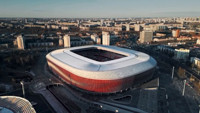
04.2025 © Иван Левонюк 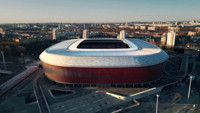
04.2025 © Иван Левонюк 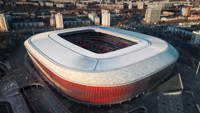
04.2025 © Иван Левонюк 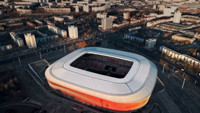
04.2025 © Иван Левонюк 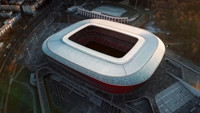
04.2025 © Иван Левонюк 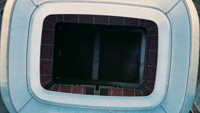
04.2025 © Иван Левонюк 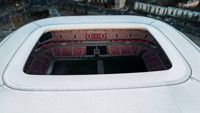
04.2025 © Иван Левонюк 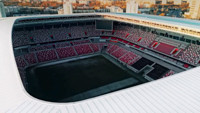
04.2025 © Иван Левонюк 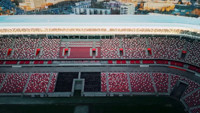
04.2025 © Иван Левонюк 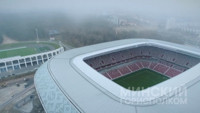
11.2024 © Минский городской исполнительный комитет 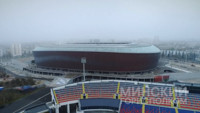
11.2024 © Минский городской исполнительный комитет 
11.2024 © Минский городской исполнительный комитет 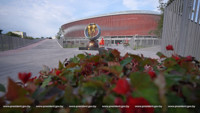
07.06.2025 © Прэзідэнт Рэспублікі Беларусь 
07.06.2025 © Прэзідэнт Рэспублікі Беларусь 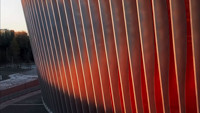
04.2025 © Иван Левонюк 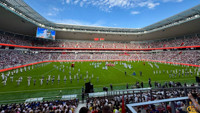
07.06.2025 © Министерство по чрезвычайным ситуациям Республики Беларусь 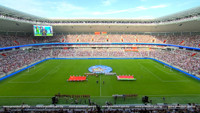
07.06.2025 © Прэзідэнт Рэспублікі Беларусь 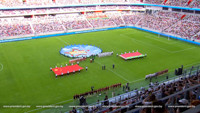
07.06.2025 © Прэзідэнт Рэспублікі Беларусь 
07.06.2025 © Прэзідэнт Рэспублікі Беларусь 
07.06.2025 © Прэзідэнт Рэспублікі Беларусь 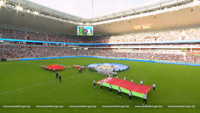
07.06.2025 © Прэзідэнт Рэспублікі Беларусь 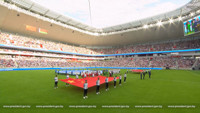
07.06.2025 © Прэзідэнт Рэспублікі Беларусь 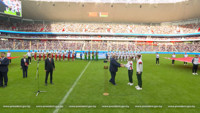
07.06.2025 © Прэзідэнт Рэспублікі Беларусь 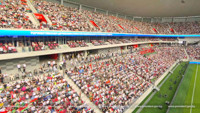
07.06.2025 © Прэзідэнт Рэспублікі Беларусь
 StadiumDB
StadiumDB